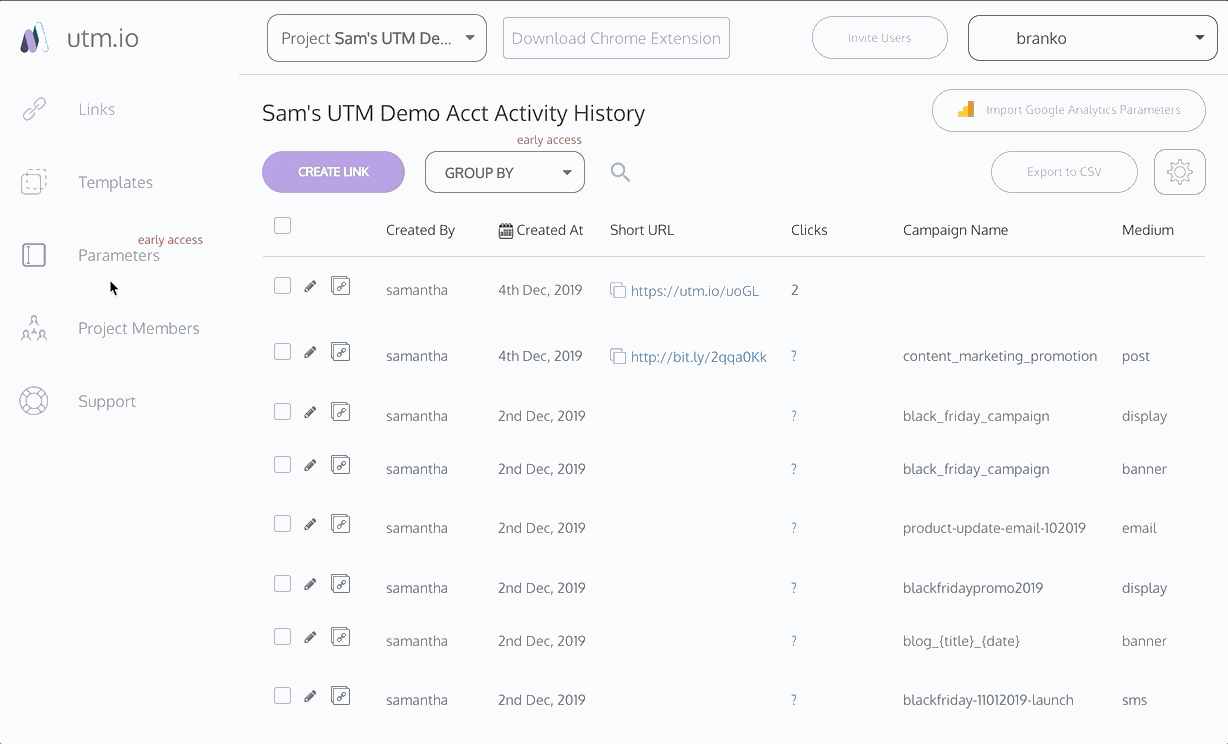How to Use the Parameter Dashboard to Speed Up and Standardize Your UTM Routine
We’re excited about the addition of the brand new Parameters Dashboard as a feature of UTM.io, and we think you’ll be excited, too. This feature was based on feedback from our users, and creative ideas from our team members. We hope you don’t just like it, we hope you love it.
The Parameters Dashboard was designed to better manage your UTM taxonomy and visualize all your saved UTM parameters. Admins and members can add, edit, or delete new UTM parameters quickly, as well as keep track of what parameters are available to viewers.
How to Add Parameters into the Dashboard - for Admins
There are four ways to add parameters into the dashboard. All of them are available to admins only.
1. Using the Parameters Dashboard
In a way very similar to how you would add cards to a Trello board, you can add parameters to the lists in your parameters dashboard.
To do this, go to the Parameters tab and just click “Add another campaign/medium/source/term/content”. Repeat and keep adding parameters to your heart’s desire.

2. Google Analytics Import
We’ve added a way to import UTM campaign parameters that already exist in your Google Analytics (GA) reports. It’s a nifty feature that’ll help you onboard new workspaces like there’s no tomorrow.
To do this, go to the Links tab or the Parameters tab and click the Import Google Analytics Parameters button in the top right corner. Then follow the steps described in our dedicated GA parameter import article. Beyond the simple how-to, the article has tricks and tips that’ll help you be more productive when setting up your UTM routine.

3. Save Parameters while Creating a Link or Template - from the App
While following the usual steps of creating a link or template in UTM.io, you’ll see a choice of parameters to pick from. If you decide to type in a parameter that’s not on the list yet, you’ll be shown the option to save it.

This option shows both in the app and in the Chrome extension.
4. Save Parameters while Creating a Link or Template - from the Chrome Extension
Just like when creating a link or template in the app, you can add and save a parameter from the Chrome extension.

The Steps for Using Saved Parameters from the Dashboard
Now that you’ve set your team up for success by only including UTM parameters that are consistent with your taxonomy, creating new links with the approved parameters is quick and easy:
- Go to the Links tab
- Click on Create Link
- Click on one of the parameter fields (Campaign/Medium/Source/Term/Content/custom). A dropdown will show, listing the parameters that have been added.
- Complete the link steps as usual.
- Enjoy thinking about how your team members now have better guidelines, right when and where they need them.Who Can Use the Parameters Dashboard
Only Admins can view the Parameters Dashboard.
But, there is a key difference between what an admin, member and a viewer can do with these parameters:
Only admins and members can save new parameters, but all your team members can use the saved parameters from the Create Link or the Create Templates tab.
To support the admin workflow and enforce UTM consistency, viewers can see and use parameters that admins have approved. Only these saved values can be used to create new links by viewers.
Are the Parameters Connected to One Workspace or Multiple Workspacess?
The parameters in the dashboard are always connected to just one workspace. This is the workspace they were created under. We’ve found that this makes it easier to remain consistent about your UTM routine.
The Benefits
To see the full flow of how to use the parameters dashboard, and to listen to our take on the benefits it’ll bring your way, check out the video below:
If you’re reading this, you probably already know that consistent UTM parameters are key to trusting your analytics reporting. But it’s really difficult to enforce the proper use of parameters, especially when managing a large team or many clients. Using consistent UTMs is everyone’s job and requires all team members to be in sync. One rogue parameter could lead to a snowball effect of bad campaign data. Therefore your plan for consistent UTM adoption for your team needs to be easy and clear. The parameter dashboard will support team-wide consistency by helping with:
- Admin control over the parameters your team can choose from
- Entering new parameters in a flexible and quick way
- Deleting bad parameter choices for your team members
- Editing any small inconsistencies like capital letters or misspellings when parameters are first added
- Shorten the learning curve for new team members
- Increased consistency of your UTMs
- Quicker onboarding of new analytics campaigns
We’re looking forward to seeing how this feature helps your work If you still need help, have feedback or ideas, please contact us.
Related documentation: